Death at the Big House: The South Galway Flying Column & the Ballyturin Ambush, Kilbeacanty, 15 May 1921
Revolution in County Galway, 1918-23
Dr Conor McNamara, Historian-in-Residence, 2022
In March 1921, frustrated at the perceived lack of militant leadership in the south of the county, a number of South Galway Volunteers from the Peterswell, Kilbeacanty, Gort and Kilchreest districts, led by John Burke and Daniel Ryan, contacted Michael Brennan, commander of the Clare Volunteers, for assistance to help setting up a flying column in south Galway. Stanford, along with a group of ten Volunteers, including Daniel Ryan and Thomas Keely, took all the ammunition and arms in their possession and met Brennan on the Derrybrien Mountains on Holy Thursday, 1921. The column was initially led by Brennan and consisted of Volunteers from Clare and Galway and was composed of about forty men.
After several unsuccessful attempts to lure the crown forces into ambushes in South Galway, Brennan took his men back to Clare, leaving the column of Galway Volunteers to organise themselves. A fortnight later, Brennan was ordered by GHQ to take full control of the South Galway Volunteers and to establish the south-east and south-west brigades consisting of five companies each. A new leadership was put in place with several younger Volunteers becoming officers for the first time. Thomas McInerney of Ardrahan became commandant, while Patrick Flynn, Derrybrien, Thomas Fahy, Peterswell, John Coen, Kilbeacanty and John Flaherty, Beagh, led their respective companies. Thomas McInerney remained in charge of the South-West (Ardrahan) Battalion while John Fahy acted as O/C of the South-East (Gort) Battalion, composed of five companies each.
The Ballyturin ambush was planned by members of this new group who were eager to prove their ruthlessness after being frustrated by the slow progress of the republican campaign in their district. Bagot House was the home of John C. Bagot, a landlord and Justice of the Peace whom Volunteer Patrick Glynn later described as “an out and out loyalist”. [explain the link between Ballyturin House and this Baggot House, please] The first major attack by the new unit was carried out at the gate lodge situated at the entrance leading to Ballyturin House, situated in the parish of Kilbeacanty. The ambush was organised by the group upon learning that District Inspector C.E.M. Blake would be attending a party at Bagot’s house. The new leadership believed that Blake came to the area to kill republicans and he instantly became infamous for raiding the Catholic Church in Kilbeacanty. During the incident, men under Blake’s command chased Volunteer Thomas Keely out of mass, firing shots on consecrated ground and damaging tombstones. It was an incident that Stanford was determined DI Blake would pay dearly for. Upon learning of Blake’s presence in the district, Stanford, Coen and Ryan fled to the remote safety of the Slieve Aughty Mountains where their camp at Gortacornane Wood was in a state of readiness.
The arrival of District Inspector Cecil A.M. Blake to South Galway in 1921 generated fear among the Volunteers in the south of the county that he would seek to exact retribution on the local community. From a wealthy family in Bournemouth, Blake had fought in France with the Royal Horse Artillery in World War One but was invalided out in early 1916. A volatile character, he was charged with forcible abduction and malicious wounding in 1916 after attempting to remove his two children from his former wife’s home in the aftermath of his divorce from her; when she had sued him for adultery. Dan Ryan later recalled the news of Blake’s arrival:
District Inspector Blake had been sent specially to Gort to kill the IRA organisation in that area. He had been a British officer during World War One and we considered him a very dangerous enemy to our forces. He had raided churches during Divine Services. On one of these raids our chief scout, Martin Coen, had a narrow escape from the guns of Blake and his men. Their bullets chipped of pieces of the headstones in Kilbeacanty Cemetery with Martin dodging from headstone to headstone until he finally got clear away under the cover of hedges.
Six Volunteers planned the Ballyturin ambush, having got word of the arrival of Blake and his party at Ballyturin House from a sister of one of the men. Volunteer officers Dan Ryan, Patrick Glynn, Thomas Keely, Joe Stanford, John Coen and Thomas Craven who was on the run from North Galway, met on the eve of the attack to put a plan together to ambush Blake. These six men were joined by four Volunteers who participated in the attack: local Volunteers John Keeley and Martin Coen, who acted as scouts, Michael Kelly, Gort, who was local intelligence officer, and Patrick Houlihan, a Volunteer from County Clare. Volunteer Patrick Glynn left a detailed description of the day’s events:
We told the two scouts of the proposed attack and instructed them to scout the road between Kilbeacanty and Ballyturin and to let us know immediately a car went into Baggots. We remained in the Wood a few hundred yards from the gate lodge. Intelligence officer Kelly went into Baggot’s grounds and lay inside the avenue leading to Baggot’s house concealed by a bed of flowers. We knew District Inspector Blake as he worked in the town of Gort as a foreman in Coen’s hardware shop. The scouts reported that the car had gone in. Kelly reported that Blake was in the car. We then moved into position to attack the car on its return journey. It was then about 1 pm. Patrick Houlihan, intelligence officer Kelly and Captain Coen had positions at the windows of the gate lodge facing the gate through which the car had come. Company Engineer Thomas Keeley was west of the lodge just a couple of yards from it. Brigadier Stanford, Brigade Quartermaster Ryan, Volunteer Craven and I took up positions in the grounds at the angle made by the avenue and the Ballyturin Road. We could not be seen from the avenue as we had cover afforded by trees and rhododendrons. We remained in position from 1 pm to after 7 pm. when the car came slowly in the direction of the gate.
The car pulled up as one side of the gate had been closed by us for that same purpose. A man left the car to go and open the gate. I didn’t know him. When he got to the gate he got the order “Hands Up” from Ryan and myself. Instead of complying he dodged for cover out of our sight. We concentrated fire on the car, doing our best to save the woman in it. The men in the lodge killed the man who came to open the gate. Blake and the other man in the car were killed and one of the women.
In relation to the killing of Eliza Blake, Dan Ryan later claimed:
“It looked as if Mrs Blake tried to fire her own or Blake’s gun. It was known that she always carried an automatic and at times threatened people in the town of Gort with it. Fire ceased and we approached the car. We found Lady Gregory in a sitting position behind the car. She looked quite cool and answered “yes” in a cool clam voice when asked if she was alright.”
Alongside Captain Blake, three others were killed in the ambush. Eliza Blake (nee Akerman), Captain F.W. Cornwallis, 17th Lancers, and Lieutenant Robert McCreery, 17th Lancers. Captain Blake and his wife were buried with military honours in the New Cemetery, Bohermore, Galway.
The woman referred to by Ryan who had survived the attack was Margaret Blake, the widowed daughter-in-law of Lady Gregory of Coole Park. W.B. Yeats had written one of his most well-known poems, An Irish Airman Foresees his Own Death, about her husband, Robert Gregory, who was shot down over Italy in January 1918. Patrick Glynn later recalled: “Lieutenant Ryan and I assisted the second woman to her feet. She was sitting in the back of the car. She asked if Mrs Blake was alright. We said she was. We linked her along the avenue for about thirty or forty yards until we met Miss Molly Baggot to whom we handed over the lady.” Following her ordeal, Margaret Gregory remained in south Galway and later married into the Gough family of Lough Cutra. She lived a long life and passed away at a nursing home in Devonshire in 1979.
In the aftermath of the ambush, the Auxiliaries shot dead a local RIC man stationed in Gort, in a wooded area adjacent to the ambush site. Constable John Kearney had been sympathetic to the local Volunteers and had passed on valuable information that allowed them evade capture. He had tendered his resignation shortly before the ambush and this may have aroused suspicion among his colleagues, who summarily executed him, afterwards placing the blame on the IRA. Thomas Keeley recalled: “I heard that he often gave information to the IRA and that he would probably have survived but for the fact that he had tendered his resignation.” (BMH/WS Keeley, p. 10) Volunteer Michael Reilly claimed:
He sent out a good deal of valuable information to Brigadier Joseph Stanford through Volunteer Henry O’Shaughnessey of Gort Company. It was well known to Volunteer officers that he was about to resign from the RIC but on the evening of the Ballyturin ambush he was killed by his own colleagues. We heard that he was the first on the scene of the ambush from Gort. We heard for certain that when the lorry arrived at Ballyturin he was ordered down off it by his own comrades and the moment he alighted he was riddled with bullets.
In the aftermath of the Ballyturin ambush, pressure on the Volunteers in south Galway greatly increased as crown forces carried out co-ordinated sweeps of the district using a convoy of lorries and an aeroplane. Martin Fahy recalled: “The enemy was so far superior in equipment and numbers that offensive action was out of the question. I and the company officers never left our area. The enemy knew this and so we kept them busy searching for us.” Joe Stanford recalled:
Raids now became so numerous that it was almost impossible to get even a bite of food at home, and all men on the run had to shift away and make groups of seven or eight, keeping what arms they had with them. Except for the few who meant to see it all through, the average company dwindled down to, in most cases, ten men. This was noted mostly in the town companies, where, with the exception of two or three intelligence men, we were mostly out of touch.
Casualties at Ballyturin
District Inspector Captain Arthur Cecil Blake, RIC
District Inspector Blake (Police Number 76106), aged 36, was from Chelmsford and fought with the Royal Horse Artillery in World War One. He previously served in the Hampshire Yeomanry and the Royal Horse Guards. He is buried in the New Cemetery, Galway, alongside his wife Eliza.
Eliza Blake, Gort
Eliza Blake (nee Akerman), the wife of the newly appointed District Inspector of RIC in South Galway, Captain Arthur Blake, was born in Lambeth, London in 1882 and had three children.
Captain Fiennes W. Cornwallis, 17th Lancers
Captain F.W. Cornwallis, 17th Lancers, Duke of Cambridge’s Own, was 30 years of age and served in France during World War One. He was stationed at Earl’s Island Barracks in Galway City.
Lieutenant Robert McCreery, 17th Lancers
Lieutenant McCreery, 17th Lancers, Duke of Cambridge’s Own, was 22 years of age and from Somerset. He was stationed at Earl’s Island Barracks in Galway City.
Constable John Kearney, RIC
Constable John Kearney was shot by crown forces in the vicinity of the ambush, having arrived at the site with a detachment of police. The crown forces suspected Kearney was aiding republicans and he was led to a wooded area nearby and shot dead. Police later claimed he was killed by republicans.
Volunteers who participated in the Ballyturin ambush, 15 May 1921:
Dan Ryan, Gortacarrane, Gort; Patrick Glynn, Lisbrien, Kilbeacanty; Thomas Keely, Kiltartan; Joe Stanford, Ballybane, Gort; John Coen, Kilbeacanty; Thomas Craven, North GalwayBrigade; John Keeley, Kilcrimple, Gort; Martin Coen, Ballycahalan; Michael Kelly, Gort; Patrick Houlihan, Feakle, Co. Clare.
The report of the attack compiled in the 1935 South-West Galway IRA Brigade Report (MA/MSPC/A/21(1)) for the Military Service Pension Board contains several inaccuracies. Volunteer Michael Reilly, among others, is listed as having participated in the attack despite stating in his own witness statement to the Bureau of Military History that he was not present at Ballyturin.
Primary Sources
Bureau of Military Witness Statement, Patrick Glynn, Kilbeacanty Company (1,033).
Bureau of Military Witness Statement, Michael Reilly, Kilbeacanty Company (1,358).
Bureau of Military Witness Statement, Joseph Stanford, South East Galway Brigade (1,334).
Bureau of Military Witness Statement, Daniel Ryan, Gort Brigade (1,037).
Bureau of Military Witness Statement, Thomas Keely, Kilbeacanty Company (1,491).
South-West Galway IRA Brigade Report (MA/MSPC/A/21(1)); Military Archives.
Further Reading
William Henry, Blood for Blood: The Black and Tan War in Galway (Mercier Press, 2001).
Conor McNamara, War & Revolution in the West of Ireland: Galway 1913–22 (Irish Academic Press, 2018).
Conor McNamara, The Loughnane Brothers, Beagh and Terror in Galway, 1920–21 (Galway County Council, 2020).
Conor McNamara, The Independence Struggle in County Galway, 1918–21, A Research Guide (Galway County Council, 2021).
Timothy McMahon (ed.), Pádraig Ó Fathaigh’s War of Independence (Cork University Press, 2000).
Cormac Ó Comhraí & K.H. O’Malley (eds), The Men Will Talk to Me, Galway Interviews by Ernie O’Malley (Mercier Press, 2015).
Cormac Ó Comhraí, Sa Bhearna Bhaoil: Gaillimh 1913–1923 (Cló Iar-Chonnacht, 2016).

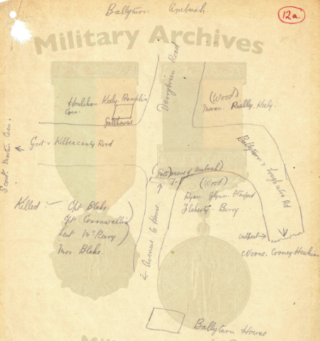
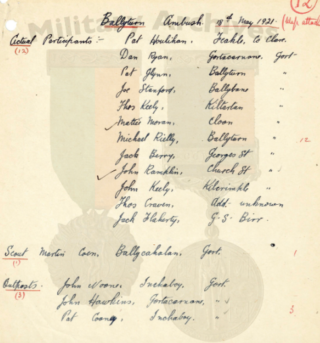
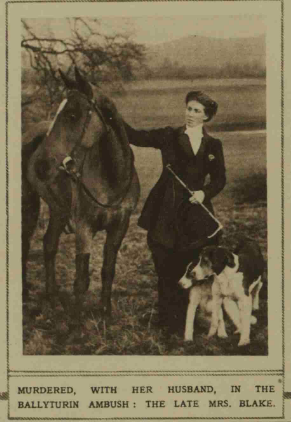
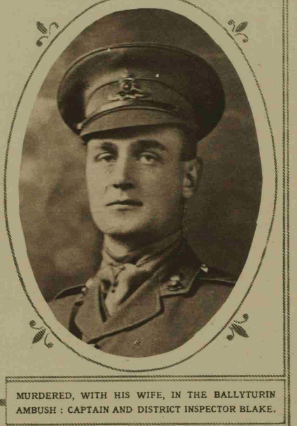
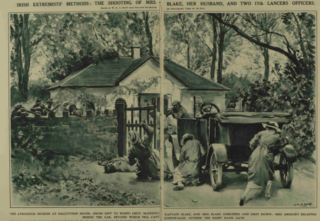








No Comments
Add a comment about this page